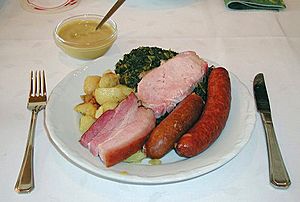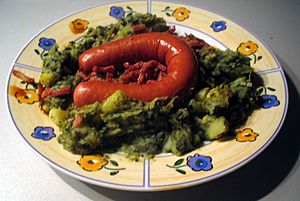Grünkohlessen facts for kids
Grünkohlessen (which means "kale eating" in German) is a fun, old winter tradition in North Germany and parts of Scandinavia, like Denmark. It's a special event that includes walking, games, and a big meal. The main food is usually kale, potatoes, and sausages.
This tradition is popular in many areas. These include the city of Bremen and nearby places like Osterholz, Diepholz, and Verden. You'll also find it in Oldenburg Land, Emsland, Hamburg, and Schleswig-Holstein.
Grünkohl is a type of kale with curly leaves. It's a kind of cabbage. Traditionally, it's picked after the first frost in autumn. The cold weather helps make the kale less bitter. Today, many types of kale are not bitter and can be picked earlier, even in September.
Contents
What is Grünkohlessen?
Grünkohlessen is more than just a meal; it's a whole event! It brings people together during the cold winter months. Friends, families, and even co-workers often plan these gatherings. It's a way to enjoy good food and company.
The Cabbage Walk (Kohlfahrt)
A big part of Grünkohlessen is the Kohlfahrt, or "cabbage walk." This is a walk through the countryside, usually in mid-winter. The walk ends at a village pub or restaurant.
- People often play games during the walk, like Boßeln. This is a sport where players throw a small ball as far as they can.
- To stay warm and get ready for the meal, people bring drinks in a trolley or handcart. These drinks are shared during the games or at special spots along the way.
The Feast
When the walkers arrive at the pub, they are served a big meal. The main dish is Grünkohl. It comes with sweet baked potatoes or boiled potatoes. Different kinds of sausages are also served, such as Kassler, Bregenwurst, Pinkel, or Kohlwurst.
- People drink a lot during the meal, which some say helps with digestion.
- After eating, there is often music and dancing.
The Cabbage King or Queen
The most exciting part of Grünkohlessen is choosing the Kohlkönig ("cabbage king") or Kohlkönigspaar ("royal cabbage couple"). There are different ways to pick the king or queen:
- Sometimes, it's based on who ate the most portions of food.
- Other times, it's decided by the results of the games played during the walk.
- The person who is the last to leave the table (not counting bathroom breaks or dancing) might also be chosen.
The Cabbage King or Queen gets to wear special chains. These chains often show the names of past kings and queens from that group. Sometimes, they even wear a pig's jawbone with a special message! The king or royal couple has an important job: they are in charge of organizing next year's Grünkohlessen.
Popular Grünkohlessen Events
Many companies, neighborhood groups, and clubs organize Grünkohlessen parties in winter. Because these events are so popular, especially on Saturdays in January and February, village inns often get fully booked many weeks in advance.
- Since 2007, one of the biggest Grünkohlessen events has taken place in Hamburg. It's held at the Fish Auction Hall near the St Pauli Landungsbrücken.
- More than 1500 guests pay to attend this big "Grünkohl-Schlemmerfest" (kale feast).
- Another well-known event is the Defftig Ollnborger Gröönkohl-Äten ("hearty Oldenburg kale feast") in Berlin. This event is organized by a group from Oldenburg Land to celebrate their traditions in the capital city.
See also
 In Spanish: Grünkohlessen para niños
In Spanish: Grünkohlessen para niños




